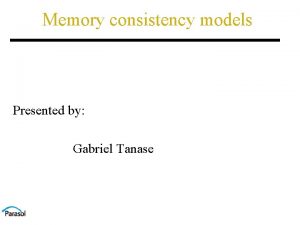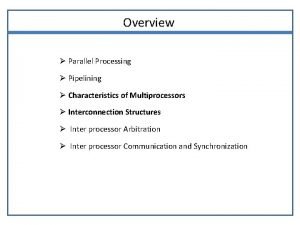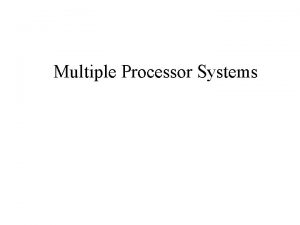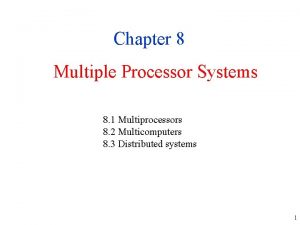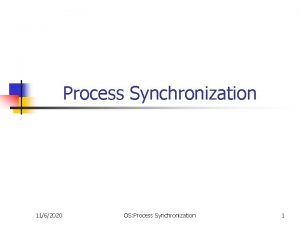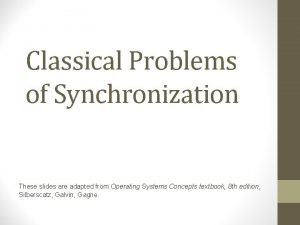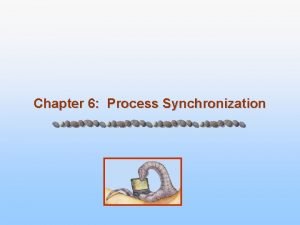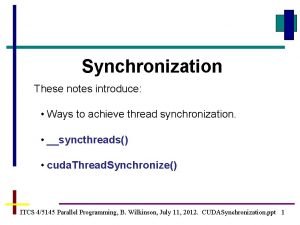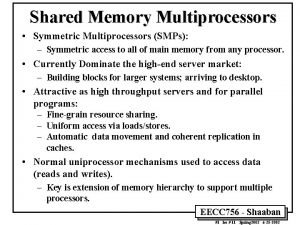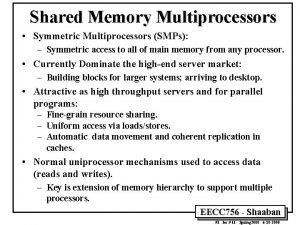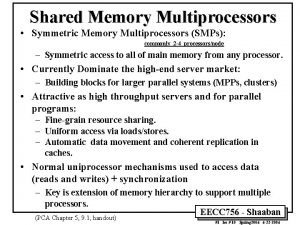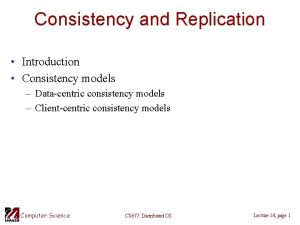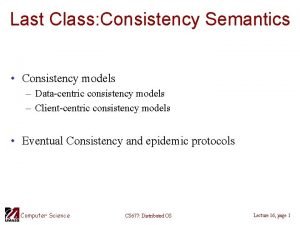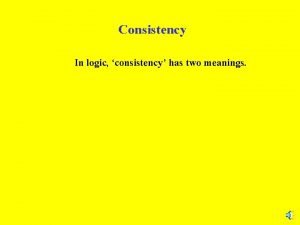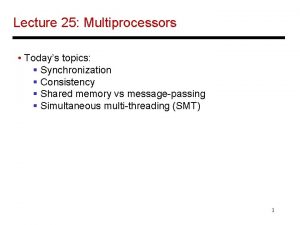Symmetric Multiprocessors Synchronization and Sequential Consistency Symmetric Multiprocessors



![A Producer-Consumer Example producer tail head Rtail Producer posting Item x: Rtail ← M[tail] A Producer-Consumer Example producer tail head Rtail Producer posting Item x: Rtail ← M[tail]](https://slidetodoc.com/presentation_image_h2/098c2cae4f816b4d498619574d63ba10/image-4.jpg)
![A Producer-Consumer Example Producer posting Item x: Rtail ← M[tail] M[<Rtail>] ← x Rtail A Producer-Consumer Example Producer posting Item x: Rtail ← M[tail] M[<Rtail>] ← x Rtail](https://slidetodoc.com/presentation_image_h2/098c2cae4f816b4d498619574d63ba10/image-5.jpg)








![Nonblocking Synchronization Compare&Swap(a, Rt, Rs): implicit arg -status if (<Rt> == M[a]) then �� Nonblocking Synchronization Compare&Swap(a, Rt, Rs): implicit arg -status if (<Rt> == M[a]) then ��](https://slidetodoc.com/presentation_image_h2/098c2cae4f816b4d498619574d63ba10/image-14.jpg)




![N-process Mutual Exclusion Lamport’s Bakery Algorithm Process i Initially num[j] = 0, for all N-process Mutual Exclusion Lamport’s Bakery Algorithm Process i Initially num[j] = 0, for all](https://slidetodoc.com/presentation_image_h2/098c2cae4f816b4d498619574d63ba10/image-19.jpg)



- Slides: 22

Symmetric Multiprocessors: Synchronization and Sequential Consistency

Symmetric Multiprocessors Processor CPU-Memory bus bridge Memory I/O controller symmetric • All memory is equally far away from all processors • Any processor can do any I/O (set up a DMA transfer) I/O controller Networks

Synchronization The need for synchronization arises whenever there are parallel processes in a system (even in a uniprocessor system) Forks and Joins: In parallel programming a parallel process may want to wait until several events have occurred Producer-Consumer: A consumer process must wait until the producer process has produced data Exclusive use of a resource: Operating system has to ensure that only one process uses a resource at a given time fork P 1 P 2 join producer consumer
![A ProducerConsumer Example producer tail head Rtail Producer posting Item x Rtail Mtail A Producer-Consumer Example producer tail head Rtail Producer posting Item x: Rtail ← M[tail]](https://slidetodoc.com/presentation_image_h2/098c2cae4f816b4d498619574d63ba10/image-4.jpg)
A Producer-Consumer Example producer tail head Rtail Producer posting Item x: Rtail ← M[tail] M[<Rtail>] ← x Rtail ← <Rtail> + 1 M[tail] ← <Rtail> consumer Rtail Rhead R Consumer: Rhead ← M[head] spin: Rtail ← M[tail] if <Rhead>== <Rtail> R ← M[<Rhead>] Rhead ← <Rhead> + 1 M[head] ← <Rhead> process(R) The program is written assuming instructions are executed in order. Possible problems? What is the problem? Suppose the tail pointer gets updated before the item x is stored? Suppose R is loaded before x has been stored?
![A ProducerConsumer Example Producer posting Item x Rtail Mtail MRtail x Rtail A Producer-Consumer Example Producer posting Item x: Rtail ← M[tail] M[<Rtail>] ← x Rtail](https://slidetodoc.com/presentation_image_h2/098c2cae4f816b4d498619574d63ba10/image-5.jpg)
A Producer-Consumer Example Producer posting Item x: Rtail ← M[tail] M[<Rtail>] ← x Rtail ← <Rtail> + 1 M[tail] ← <Rtail> Consumer: Rhead ← M[head] spin: Rtail ← M[tail] if <Rhead>== <Rtail> R ← M[<Rhead>] Rhead ← <Rhead> + 1 M[head] ← <Rhead> process(R) Programmer assumes that if 3 happens after 2, then 4 happens after 1. Problems are: Sequence 2, 3, 4, 1 Sequence 4, 1, 2, 3 Programmer assumes that if 3 happens after 2, then 4 happens after 1.

Sequential Consistency: A Memory Model “A system is sequentially consistent if the result of any execution is the same as if the operations of all the processors were executed in some sequential order, and the operations of each individual processor appear in the order specified by the program” Leslie Lamport Sequential Consistency = arbitrary order-preserving interleaving of memory references of sequential programs

Sequential Consistency Concurrent sequential tasks: T 1, T 2 Shared variables: X, Y (initially X = 0, Y = 10) T 1: T 2: Store(X, 1) (X = 1) Store(Y, 11) (Y = 11) Load(R 1, Y) Store(B, R 1) (B = Y) Load(R 2, X) Store(A, R 2) (A = X) what are the legitimate answers for A and B ? (A, B) ∈ { (1, 11), (0, 10), (1, 10), (0, 11) } ? (0, 11) is not legit.

Sequential Consistency Sequential consistency imposes additional memory ordering constraints in addition to those imposed by uniprocessor program dependencies What are these in our example ? Does (can) a system with caches, write buffers, or out-of-order execution capability provide a sequentially consistent view of the memory ? More on this later

Multiple Consumer Example producer tail head consumer 1 Rtail Rhead R Rtail consumer 2 Rtail Rhead R Consumer: Rhead ← M[head] spin: Rtail ← M[tail] if <Rhead>== <Rtail> M[<Rtail>] ← x R ← M[<Rhead>] Rtail ← <Rtail> + 1 Rhead ← <Rhead> + 1 M[tail] ← <Rtail> M[head] ← <Rhead> process(R) What is wrong with this code? Producer posting Item x:

Multiple Consumer Example producer tail head consumer 1 consumer 2 Producer posting Item x: Consumer: Rhead ← M[head] Rtail ← M[tail] spin: M[<Rtail>] ← x if <Rhead>== <Rtail> Rtail ← <Rtail> + 1 R ← M[<Rhead>] M[tail] ← <Rtail> Rhead ← <Rhead> + 1 Critical Section: M[head] ← <Rhead> Needs to be executed atomically process(R) by one consumer ⇒ locks

Locks or Semaphores: E. W. Dijkstra, 1965 A semaphore is a non-negative integer, with the following operations: P(s): if s > 0 decrement s by 1 otherwise wait V(s): increment s by 1 and wake up one of the waiting processes P’s and V’s must be executed atomically, i. e. , without • interruptions or • interleaved accesses to s by other processors Process i P(s) <critical section> V(s) What does initial value of s determine? The maximum number of processes in the critical section. A sempahore is a visual system for sending information based on 2 flag sheld In each hand.

Implementation of Semaphores (mutual exclusion) can be implemented using ordinary Load and Store instructions in the Sequential Consistency memory model. However, protocols for mutual exclusion are difficult to design. . . Simpler solution: atomic read-modify-write instructions Examples: (a is a memory address, R is a register) Test&Set(a, R): R ← M[a]; if <R>==0 then M[a] ← 1; Fetch&Add(a, RV, R): R ← M[a]; M[a] ← <R> + <RV>; Swap(a, R): Rt ← M[a]; M[a] ← <R>; R ← <Rt>;

Multiple Consumers Example: using the Test & Set Instruction P: Test&Set(mutex, Rtemp) if (<Rtemp> != 0) goto P Rhead ← M[head] spin: Rtail ← M[tail] if <Rhead> == <Rtail> goto spin R ← M[<Rhead>] Rhead ← <Rhead> + 1 M[head] ← <Rhead > V: 0) V: Store(mutex, 0) process(R) Critical Section Other atomic read-modify-write instructions (Swap, Fetch&Add, etc. ) can also implement P’s and V’s What is the problem with this code? What if the process stops or is swapped out while in the critical section?
![Nonblocking Synchronization CompareSwapa Rt Rs implicit arg status if Rt Ma then Nonblocking Synchronization Compare&Swap(a, Rt, Rs): implicit arg -status if (<Rt> == M[a]) then ��](https://slidetodoc.com/presentation_image_h2/098c2cae4f816b4d498619574d63ba10/image-14.jpg)
Nonblocking Synchronization Compare&Swap(a, Rt, Rs): implicit arg -status if (<Rt> == M[a]) then �� M[a] ← <Rs>; Rt ← <Rs>; status ← success; else status ← fail; try: Rhead ← M[head] spin: Rtail ← M[tail] if <Rhead> == <Rtail> goto spin R ← M[<Rhead>] Rnewhead ← <Rhead> + 1 Compare&Swap(head, Rnewhead) if (status == fail) goto try process(R)

Load-reserve & Store-conditional Non-blocking Synchronization Special register(s) to hold reservation flag and address, and the outcome of store-conditional Load-reserve(R, a): <flag, adr> ← <1, a>; R ← M[a]; Store-conditional(a, R): if <flag, adr> == <1, a> then cancel other procs’ reservation on a; M[a] ← <R>; status ← succeed; else status ← fail; try: Load-reserve(Rhead, head) spin: Rtail ← M[tail] if < Rhead >== < Rtail> goto spin R ← M[< Rhead >] Rhead ← < Rhead > + 1 Store-conditional(head, Rhead) if (status == fail) goto try process(R)

Mutual Exclusion Using Load/Store A protocol based on two shared variables c 1 and c 2 Initially. , both c 1 and c 2 are 0 (not busy) Process 1. . . c 1 = 1; L: if c 2 == 1 then go to L < critical section > c 1 = 0; What is wrong? Process 2. . . c 2 = 1; L: if c 1 == then go to L < critical section > c 2 = 0;

Synchronization To avoid deadlock, let process give up reservation (i. e. , Process 1 sets c 1 to 0) while waiting. Process 1. . . L: c 1 = 1; if c 2 == 1 then { c 1 = 0; goto L } < critical section > c 1 = 0; Process 2. . . L: c 2 = 1; if c 1 == 1 then { c 2 = 0; goto L } < critical section > c 2 = 0; Deadlock is not possible. What could go wrong? This is the most promising solution, but alas, we still have a problem with bounded waiting. Suppose Process j continually reenters its entry protocol after leaving its exit protocol, while Process i is waiting. It is possible That Process j will repeatedly reach the while test when Process i has temporarily cleared its flag. We cannot place a bound on how many times this could happen.

A Protocol for Mutual Exclusion T. Dekker, 1966 A protocol based on 3 shared variables c 1, c 2 and turn. itially, both c 1 and c 2 are 0 (not busy) Process 1. . . c 1 = 1; turn = 1; L: if c 2 == 1 && turn == 1 then goto L < critical section > c 1 = 0; Process 2. . . c 2 = 1; turn = 2; L: if c 1 == 1 && turn == 2 then goto L < critical section > c 2 = 0; • turn = i ensures that only process i can wait • variables c 1 and c 2 ensure mutual exclusion Take a number approach used in bakeries. Never seen one in bakeries, but the RMV uses one.
![Nprocess Mutual Exclusion Lamports Bakery Algorithm Process i Initially numj 0 for all N-process Mutual Exclusion Lamport’s Bakery Algorithm Process i Initially num[j] = 0, for all](https://slidetodoc.com/presentation_image_h2/098c2cae4f816b4d498619574d63ba10/image-19.jpg)
N-process Mutual Exclusion Lamport’s Bakery Algorithm Process i Initially num[j] = 0, for all j Entry Code choosing[i] = 1; num[i] = max(num[0], …, num[N-1]) + 1; choosing[i] = 0; for(j = 0; j < N; j++) while( choosing[j] ); while( num[j] && ( ( num[j] < num[i] ) || ( num[j] == num[i] && j < i ) ) ); } Exit Code num[i] = 0; Wait if the process is currently choosing Wait if the process has a number and comes ahead of us.

Implementation Issues Implementation of SC is complicated by two issues • Out-of-order execution capability Load(a); Load(b) yes Load(a); Store(b) yes if a ≠ b Store(a); Load(b) yes if a ≠ b Store(a); Store(b) yes if a ≠ b • Caches can prevent the effect of a store from being seen by other processors

Memory Fences: Instructions to serialize memory accesses Processors with relaxed or weak memory models (i. e. , permit Loads and Stores to different addresses to be reordered) need memory fence instructions to force serialization of memory accesses Processors with relaxed memory models: Sparc V 8 (TSO, PSO): Membar Power. PC (WO): nc, EIEIO Memory fences are expensive operations, however, one pays for serialization only when it is required Sy

Using Memory Fences producer tail Producer posting Item x: head consumer Consumer: Rhead ← M[head] spin: Rtail ← M[tail] if <Rhead>== <Rtail> membar. LL R ← M[<Rhead>] M[tail] ← <Rtail> Rhead ← <Rhead> + 1 What does this ensure? M[head] ← <Rhead> What does this ensure? process(R) Rtail ← M[tail] M[<Rtail>] ← x membar. SS Rtail = <Rtail> + 1 Ensures that tail pointer is not updated before X has been stored. Ensures that R is not loaded before x has been stored.
 Replicated data consistency explained through baseball
Replicated data consistency explained through baseball Processor consistency model
Processor consistency model Define symmetric matrix
Define symmetric matrix Characteristics of multiprocessor
Characteristics of multiprocessor Multiprocessors are classified as
Multiprocessors are classified as Uma multiprocessors using multistage switching networks
Uma multiprocessors using multistage switching networks Multiple processor systems
Multiple processor systems Synchronization algorithms and concurrent programming
Synchronization algorithms and concurrent programming Fast clock to slow clock synchronization
Fast clock to slow clock synchronization Types of semaphore in os
Types of semaphore in os Process synchronization in os
Process synchronization in os Data synchronization in tally
Data synchronization in tally Multiprocessor synchronization
Multiprocessor synchronization Lean synchronization
Lean synchronization Bgp states
Bgp states Lock free synchronization
Lock free synchronization Classical problem of synchronization in operating system
Classical problem of synchronization in operating system Synchronization tool in os
Synchronization tool in os Process synchronization in os
Process synchronization in os Basic synchronization principles
Basic synchronization principles Windchill commonspace
Windchill commonspace Syncthreads
Syncthreads Process synchronization means
Process synchronization means

